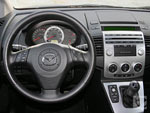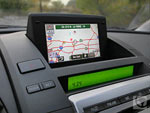 As heard in Animaniacs:
As heard in Animaniacs:"I'd like a small popcorn, please."
"We don't have small."
"What do you have?"
"Large, Extra Large, and Super Chubby."
"Wouldn't that make a large a small?"
"I'll have to ask my manager."
While you're at it, lad, ask if he can explain a similar semantic discrepancy plaguing America's family transporter, the minivan. The "van" part is spot-on, but for something that stretches longer than a pole vault, stands taller than the average adult, and can haul away half the contents in Wells Fargo's safe, is "mini" really the word that springs to the surface?
It did once, back when the original Dodge Caravans and Honda Odysseys roamed the land. But ever since those tidy street shuttles underwent their dramatic overnight growth spurts, Mazda has been taking a lot of flak for its "too small" and "underpowered" MPV. Hey, everyone responds to pressure differently. For its new minivan, dubbed the 5, Mazda has opted to take that MPV, shrink it, lop off two cylinders, and subtract 43 horsepower. Huh?
Whatever you make of the product, let's score one for truth in labeling.
Road Test

The root of the downsizing is the switch of architecture: instead of the 626-based MPV, this 5 rides on a version of the 3, Mazda's smallest car. Even in a class of vehicle that's antithetical to pleasure, smallness brings tangible rewards. The 5 has an unmistakably road-friendly character apparent in its responses and ease of parking, and the edge in visibility doesn't hurt. With a length of 182 inches and a width of 69, the 5 slots in right where its name implies: between the 3 and 6. Its sub-35-foot turning circle bests even the 6, though its character leans closer to the 3.
It shares the same front strut and rear multilink suspensions and dual stabilizer bars, which provide a ride that's slightly firm but definitely easy enough on the kids. No kids around? 17-inch tires harness enough sticking power to let you get a little crazy. The 5's tall profile causes some body lean in corners, but the low-for-a-van seats help keep that down. 4-wheel disc brakes with standard antilock/EBD/EBA are shared (the 5's rear rotors are bigger) and they feel just right. There's the same electrohydraulic steering, which turns the 5 quickly - maybe a little too quickly when turning just off center, where it's eager to return. It's good, but why didn't Mazda just yank the awesome steering rack off a Ford Focus (the basis for both the 3 and 5)? As in all Mazdas, moderate road noise is the main source of intrusion.
Parts-sharing goes a step too far when it comes to powertrains. The combination of 157 horsepower and 148 pounds-feet of torque turns from peppy to pathetic when you take 2,859 pounds (Mazda 3 wagon) and pile on another 540. Flooring the 5's pedal causes an uneventful, barely adequate reaction - and that's with just one of me on board, with the rare advantage of a manual transmission (I'd requested an auto). I'm never one to encourage excess power, but now that society holds vans and cars to the same speed standards (fact: the 5 could still dust most 20th century minivans), taking more than 10 seconds to reach 60 MPH is blasphemy. We need a V6 for the 5 to come alive; too bad Mazda hasn't made any since 2002.
Anyone who plans to take advantage of the only minivan to offer a stick can rejoice that the 5 has a smooth and gradual clutch, and that the lever snicks firmly and definitely through its gates - the first four, anyway. After getting used to the dorky long throws, it does add to the fun.
Since 90% of parental minds and hands will be too distracted by tweens or toddlers to worry about shifting, know that the automatic shifts just fine in the 3, and it has a manual mode. However, applying any automatic to the 5 might result in some "hunting" as the computer downshifts constantly to find what little power there is. Watch for that on your test drive.
Aside from having only four gears in that automatic, the 5 is pretty equivalent to the more technically proficient vans. Compared to them, the 5's mini-engine had less impact on this scribe's driving impression than the mini-everything-else, so in the end, Mazda gets to walk away the winner in the "Most Fun Van" sweepstakes. That's not something to hang your hat on, but it is something.
Inside & Out

It's good news that the inspired dashboards showing up in recent Mazdas have made the cut in only slightly altered form. The leather-covered steering wheel's cruise and audio controls are set up perfectly. Center stack material looks and feels like real heavy metal, and meshes with the black surroundings in a most phat manner. The stereo's a little short on bass and shorter on features, but sounds pleasingly crisp and clean. The black clock in the bright green background is a refreshing change of visual pace, and the glovebox is deeper than Descartes. All buttons have a tightness to them, all systems are located where they should be, and when you order the navigation system - which pops out of the top of the dash and doesn't take up space - it doesn't mess with the other systems.
Oh yeah, Mazda has a navigation system too now, didn't you know? It generally works like the other Japanese systems - that's generally good - but shares the complaint I most often lodge at Nissans: the do-everything knob often mistakes push-downs for a tilt-a-whirl motions and vice versa. It's also the type that locks out user input whenever the van's in motion. Both are annoying. It's otherwise logical and user-friendly.
A telescoping steering column and a great front seat mean comfort comes quickly. And as a side benefit of a vehicle in which "you can get up and walk around" is endless headroom. First complaint: the need to push a button to release the key from the ignition is a dumb annoyance that everyone else solved around 1988. Second complaint: the 5 overdoses on the mini-ness once again, with its inflexible rearward track travel severely constraining legroom for anyone over six feet.
Oh well, vans aren't about you anyway. They're about carrying lots of people, and your first three guests will feel just fine. All four of you basically get the same bucket seat, which is comfortable in its padding, shaping, and material. Every seat in the house also gets a 3-point belt, an adjustable head restraint, a side curtain air bag, and most importantly, one cupholder. Mr. Shotgun gets cheated out of a center armrest, though, and second-row riders don't get any on the doors. Hmm...
Exceeding four is when the compromises ensue. Unless you want all hell to break loose behind you, make sure there's a strong inverse relation between the age/size of occupants in the second and third rows. Each row gets five fewer inches of legroom than the one ahead, and with adults seated normally in the second, space in the third borders on torturous in every respect besides headroom. Feet will suffer especially under the badly-designed second-row seats, and when the second-row guys are asked to show mercy and move forward, they'll face the same foot problem under the first row.
Legs, arms, feet... Mazda's always forgetting something. Things should be perfectly fine if everyone behind you is under 10. Just be sure the six of you don't have a lot of stuff, or else the Mazda 5's Mazda 3-like body length must be dealt with.
One great advantage of having six individual seats - aside from every passenger controlling his own destiny - is the flexibility it lends to cargo loading. The 5's rearmost seats fold down just as easily as in the van that pioneered this, the Odyssey. The second-row seats fold (or slide) equally easily and form a flat floor. However, none of the 5's seats can be removed like in most vans, limiting max cargo potential. Curiously, Mazda makes its van look worse by listing the "third row seats folded" spec - 44.4 cubic feet - as the maximum capacity figure. Why sell yourself short? Knowing a puny Scion xB can carry 43, a Mazda 5 with all seats down could probably carry around 70. Or something.
Other Thoughts

More Mazda modesty is found in the 5's MSRP, which at only $18,895 to start (subtract $900 for the manual version) outprices the base Mazda 3 wagon by a paltry 15 bucks - one meal at Olive Garden. And if you upgrade to the 3 Touring wagon to match the 5's airbags, the 5 ends up $230 cheaper!
Scanning the minivan landscape reveals consistent findings. The Grand Car Caravan, Freestar, Sienna, Quest, and Odyssey command 24, 24, 24, 25, and 26 to start; even Kia wants $23,665 for their Sedona LX. A new short-length Chevrolet Uplander joins the short-length Dodge Caravan (of the non-Grand variety) to give the 5 two competitors of similar size. Both start close to the 5 in the 19-grand range, but are somewhat stripped of equipment and short on mechanical technology.
That $18,895 buys the 5 Sport model. The mostly similar Touring upgrades this ride with fog lights, body-color mirrors, side sill extensions, moonroof, tweeter speakers, 6-disc CD changer, automatic A/C, outside temperature display, leather steering wheel, and a cargo bin between the second-row seats (which can disappear into one of them). $1,515 pays for all this extra stuff on the $20,410 Touring model, which is the only place to find the $2,000 navigation system. Rear-seat DVD is optional on both for $1,200; leather is strangely unavailable on either.
With little question that Mazda's asking a fair sum, the issues become what you're paying for here and whether you have to. If upgrading from car to van for one extra seat sounds like overkill, remember that the 5 is also a superior five-seater: the fifth guy is more comfortable in isolation, and he doesn't compromise the comfort of the third and fourth. The 5 also makes sense to four-member units that collectively haul around enough junk to fill 44.4 cubic feet (vs. 17.1 in a 3 wagon with all seats upright).
In jumping from 3 to 5, the drawbacks end after the extra 540 pounds of weight (about six kids) dulling all reactions, and the poorer fuel economy. This sample returned 21 MPG - let's pretend this were an automatic and call that 20 - approximately 4 to 5 less than what a 3 wagon could achieve. At 5'5", the 5 is still somewhat tall, and apparently the 0.29 drag coefficient (very good for a van) doesn't compensate as much as you'd think. None of that's Mazda's fault, you understand.
If you want to keep the advantages of a car and just want a little more space than a 3 has to offer, don't forget that Mazda makes one of the few mid-size wagons, the 6. A 220-horsepower V6 puts it a flight of stairs above the 5 in performance while matching its fuel economy, it's a fun handler with a fine back seat, and its cargo hold expands from 33.7 to 60.5 cubes. It does cost $25K for an automatic, though, and it's not as reliable as the Hiroshima-built 3 and 5. [source : automotive.com]
Post a Comment